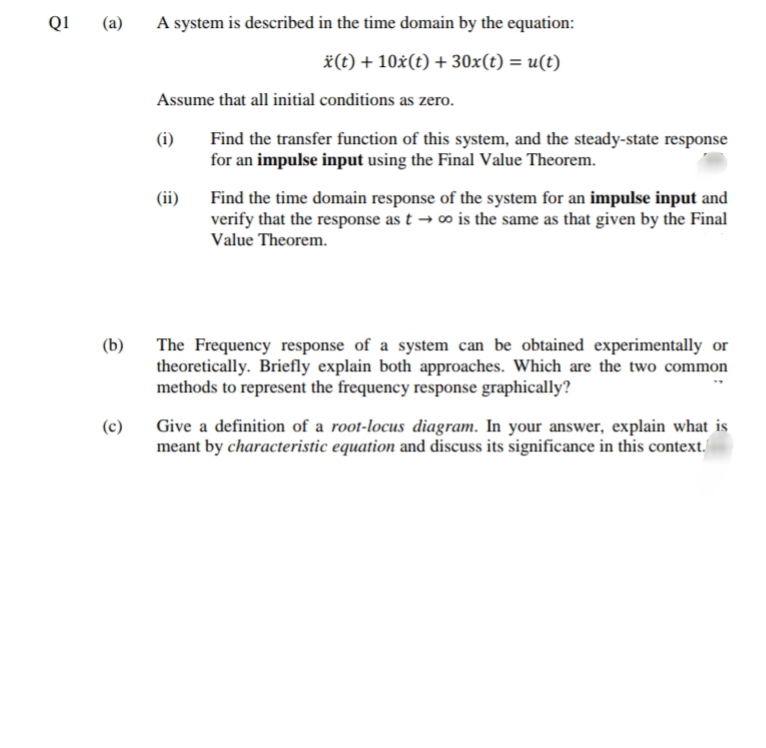QI (a) A system is described in the time domain by the equation: *(t) + 10×(t) + 30x(t) = u(t) %3D Assume that all initial conditions as zero. Find the transfer function of this system, and the steady-state response for an impulse input using the Final Value Theorem. (i) Find the time domain response of the system for an impulse input and verify that the response as t→ o is the same as that given by the Final Value Theorem. (ii) The Frequency response of a system can be obtained experimentally or theoretically. Briefly explain both approaches. Which are the two common methods to represent the frequency response graphically? (b) Give a definition of a root-locus diagram. In your answer, explain what is meant by characteristic equation and discuss its significance in this context. (c)
QI (a) A system is described in the time domain by the equation: *(t) + 10×(t) + 30x(t) = u(t) %3D Assume that all initial conditions as zero. Find the transfer function of this system, and the steady-state response for an impulse input using the Final Value Theorem. (i) Find the time domain response of the system for an impulse input and verify that the response as t→ o is the same as that given by the Final Value Theorem. (ii) The Frequency response of a system can be obtained experimentally or theoretically. Briefly explain both approaches. Which are the two common methods to represent the frequency response graphically? (b) Give a definition of a root-locus diagram. In your answer, explain what is meant by characteristic equation and discuss its significance in this context. (c)
Computer Networking: A Top-Down Approach (7th Edition)
7th Edition
ISBN:9780133594140
Author:James Kurose, Keith Ross
Publisher:James Kurose, Keith Ross
Chapter1: Computer Networks And The Internet
Section: Chapter Questions
Problem R1RQ: What is the difference between a host and an end system? List several different types of end...
Related questions
Question

Transcribed Image Text:Q1
(a)
A system is described in the time domain by the equation:
*(t) + 10x(t) + 30x(t) = u(t)
Assume that all initial conditions as zero.
Find the transfer function of this system, and the steady-state response
for an impulse input using the Final Value Theorem.
(ii)
Find the time domain response of the system for an impulse input and
verify that the response as t → o is the same as that given by the Final
Value Theorem.
(b)
The Frequency response of a system can be obtained experimentally or
theoretically. Briefly explain both approaches. Which are the two common
methods to represent the frequency response graphically?
(c)
Give a definition of a root-locus diagram. In your answer, explain what is
meant by characteristic equation and discuss its significance in this context.
Expert Solution
This question has been solved!
Explore an expertly crafted, step-by-step solution for a thorough understanding of key concepts.
Step by step
Solved in 3 steps with 3 images

Recommended textbooks for you

Computer Networking: A Top-Down Approach (7th Edi…
Computer Engineering
ISBN:
9780133594140
Author:
James Kurose, Keith Ross
Publisher:
PEARSON

Computer Organization and Design MIPS Edition, Fi…
Computer Engineering
ISBN:
9780124077263
Author:
David A. Patterson, John L. Hennessy
Publisher:
Elsevier Science

Network+ Guide to Networks (MindTap Course List)
Computer Engineering
ISBN:
9781337569330
Author:
Jill West, Tamara Dean, Jean Andrews
Publisher:
Cengage Learning

Computer Networking: A Top-Down Approach (7th Edi…
Computer Engineering
ISBN:
9780133594140
Author:
James Kurose, Keith Ross
Publisher:
PEARSON

Computer Organization and Design MIPS Edition, Fi…
Computer Engineering
ISBN:
9780124077263
Author:
David A. Patterson, John L. Hennessy
Publisher:
Elsevier Science

Network+ Guide to Networks (MindTap Course List)
Computer Engineering
ISBN:
9781337569330
Author:
Jill West, Tamara Dean, Jean Andrews
Publisher:
Cengage Learning

Concepts of Database Management
Computer Engineering
ISBN:
9781337093422
Author:
Joy L. Starks, Philip J. Pratt, Mary Z. Last
Publisher:
Cengage Learning

Prelude to Programming
Computer Engineering
ISBN:
9780133750423
Author:
VENIT, Stewart
Publisher:
Pearson Education

Sc Business Data Communications and Networking, T…
Computer Engineering
ISBN:
9781119368830
Author:
FITZGERALD
Publisher:
WILEY